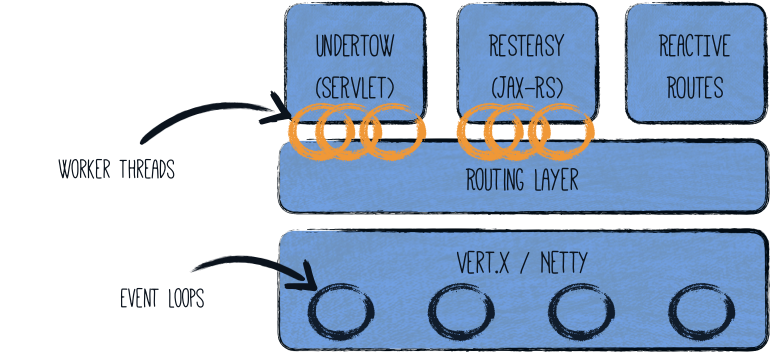Using Reactive Routes
Reactive routes propose an alternative approach to implement HTTP endpoints where you declare and chain routes. This approach became very popular in the JavaScript world, with frameworks like Express.Js or Hapi. Quarkus also offers the possibility to use reactive routes. You can implement REST API with routes only or combine them with JAX-RS resources and servlets.
The code presented in this guide is available in this Github repository under the reactive-routes-quickstart directory
Quarkus HTTP
Before going further, let’s have a look at the HTTP layer of Quarkus. Quarkus HTTP support is based on a non-blocking and reactive engine (Eclipse Vert.x and Netty). All the HTTP requests your application receive are handled by event loops (IO Thread) and then are routed towards the code that manages the request. Depending on the destination, it can invoke the code managing the request on a worker thread (Servlet, Jax-RS) or use the IO Thread (reactive route). Note that because of this, a reactive route must be non-blocking or explicitly declare its blocking nature (which would result by being called on a worker thread).

Declaring reactive routes
The first way to use reactive routes is to use the @Route annotation.
To have access to this annotation, you need to add the quarkus-vertx-web extension:
In your pom.xml file, add:
<dependency>
<groupId>io.quarkus</groupId>
<artifactId>quarkus-vertx-web</artifactId>
</dependency>Then in a bean, you can use the @Route annotation as follows:
package org.acme.reactive.routes;
import io.quarkus.vertx.web.Route;
import io.quarkus.vertx.web.RoutingExchange;
import io.vertx.core.http.HttpMethod;
import io.vertx.ext.web.RoutingContext;
import javax.enterprise.context.ApplicationScoped;
@ApplicationScoped (1)
public class MyDeclarativeRoutes {
// neither path nor regex is set - match a path derived from the method name
@Route(methods = HttpMethod.GET) (2)
void hello(RoutingContext rc) { (3)
rc.response().end("hello");
}
@Route(path = "/greetings", methods = HttpMethod.GET)
void greetings(RoutingExchange ex) { (4)
ex.ok("hello " + ex.getParam("name").orElse("world"));
}
}| 1 | If there is a reactive route found on a class with no scope annotation then @javax.inject.Singleton is added automatically. |
| 2 | The @Route annotation indicates that the method is a reactive route. Again, by default, the code contained in the method must not block. |
| 3 | The method gets a RoutingContext as a parameter. From the RoutingContext you can retrieve the HTTP request (using request()) and write the response using response().end(…). |
| 4 | RoutingExchange is a convenient wrapper of RoutingContext which provides some useful methods. |
More details about using the RoutingContext is available in the Vert.x Web documentation.
The @Route annotation allows to configure:
-
The
path- for routing by path, using the Vert.x Web format -
The
regex- for routing with regular expressions, see for more details -
The
methods- the HTTP verb triggering the route such asGET,POST… -
The
type- it can be normal (non-blocking), blocking (method dispatched on a worker thread), or failure to indicate that this route is called on failures -
The
order- the order of the route when several routes are involved in handling the incoming request. Must be positive for regular user routes. -
The produced and consumed mime types using
produces, andconsumes
For instance, you can declare a blocking route as follows:
@Route(methods = HttpMethod.POST, path = "/post", type = Route.HandlerType.BLOCKING)
public void blocking(RoutingContext rc) {
// ...
}You can also declare several routes for a single method using @Routes:
@Route(path = "/first")
@Route(path = "/second")
public void route(RoutingContext rc) {
// ...
}Each route can use different paths, methods…
@RouteBase
This annotation can be used to configure some defaults for reactive routes declared on a class.
@RouteBase(path = "simple", produces = "text/plain") (1)
public class SimpleRoutes {
@Route(path = "ping") // the final path is /simple/ping
void ping(RoutingContext rc) {
rc.response().end("pong");
}
}| 1 | The path value is used as a prefix for any route method declared on the class where Route#path() is used. The produces value is used for content-based routing for all routes where Route#produces() is empty. |
Using the Vert.x Web Router
You can also register your route directly on the HTTP routing layer by registering routes directly on the Router object.
To retrieve the Router instance at startup:
public void init(@Observes Router router) {
router.get("/my-route").handler(rc -> rc.response().end("Hello from my route"));
}Check the Vert.x Web documentation to know more about the route registration, options, and available handlers.
|
|
Intercepting HTTP requests
You can also register filters that would intercept incoming HTTP requests. Note that these filters are also applied for servlets, JAX-RS resources, and reactive routes.
For example, the following code snippet registers a filter adding an HTTP header:
package org.acme.reactive.routes;
import io.vertx.ext.web.RoutingContext;
public class MyFilters {
@RouteFilter(100) (1)
void myFilter(RoutingContext rc) {
rc.response().putHeader("X-Header", "intercepting the request");
rc.next(); (2)
}
}| 1 | The RouteFilter#value() defines the priority used to sort the filters - filters with higher priority are called first. |
| 2 | The filter is likely required to call the next() method to continue the chain. |
 中文翻译站
中文翻译站

